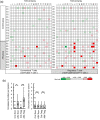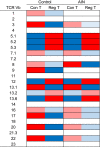Possible involvement of regulatory T cell abnormalities and variational usage of TCR repertoire in children with autoimmune neutropenia
- PMID: 33289074
- PMCID: PMC7944361
- DOI: 10.1111/cei.13559
Possible involvement of regulatory T cell abnormalities and variational usage of TCR repertoire in children with autoimmune neutropenia
Abstract
Autoimmune neutropenia (AIN) in childhood is characterized by chronic neutropenia and positivity for anti-neutrophil antibodies, resulting in the excessive destruction of neutrophils. In this study, we investigated the involvement of regulatory T cells (Tregs ) in the pathogenesis of AIN in childhood. Tregs have been classified into three subpopulations based on the expressions of CD45RA and forkhead box protein 3 (FoxP3): resting Tregs , activated Tregs and non-suppressive Tregs . The frequency of activated Tregs (CD4+ CD25+ FoxP3high CD45RA- T cells) as well as that of total Tregs (CD4+ CD25+ FoxP3+ T cells) in peripheral blood was significantly decreased in patients with AIN. Analysis of the T cell receptor (TCR)-Vβ repertoire of CD4+ T cells revealed skewed usages in patients with AIN compared with that observed in age-matched control subjects. Regarding T cell subsets, the use of four of 24 TCR-Vβ families in Tregs and one in conventional T cells were increased in patients with AIN. The number of patients with AIN who showed skewed usages of TCR-Vβ family in conventional and Tregs was significantly higher than that reported in control subjects. When the preference between Tregs and conventional T cells in each TCR-Vβ family was individually compared, different use was prominently observed in the TCR-Vβ 9 family in patients with AIN. These results suggest that the quantitative abnormalities of Tregs and the skew of the TCR-Vβ repertoire in CD4+ T cells, including Tregs and conventional T cells, may be related to autoantibody production through a human neutrophil antigen-reactive T cell clone.
Keywords: autoimmunity; children; neutropenia; regulatory T cell; repertoire.
© 2020 British Society for Immunology.
Conflict of interest statement
The authors have no conflicts of interest to disclose.
Figures






Similar articles
-
Flow cytometric analysis of TCR Vβ repertoire in patients with 22q11.2 deletion syndrome.Scand J Immunol. 2011 Jun;73(6):577-85. doi: 10.1111/j.1365-3083.2011.02527.x. Scand J Immunol. 2011. PMID: 21323691
-
T cell receptor Vbeta repertoire of T lymphocytes and T regulatory cells by flow cytometric analysis in healthy children.Clin Exp Immunol. 2008 Jan;151(1):190-8. doi: 10.1111/j.1365-2249.2007.03536.x. Epub 2007 Nov 5. Clin Exp Immunol. 2008. PMID: 17983445 Free PMC article.
-
Thymus transplantation restores the repertoires of forkhead box protein 3 (FoxP3)+ and FoxP3- T cells in complete DiGeorge anomaly.Clin Exp Immunol. 2013 Jul;173(1):140-9. doi: 10.1111/cei.12088. Clin Exp Immunol. 2013. PMID: 23607606 Free PMC article.
-
Identity of mysterious CD4+CD25-Foxp3+ cells in SLE.Arthritis Res Ther. 2010;12(1):101. doi: 10.1186/ar2894. Epub 2010 Jan 20. Arthritis Res Ther. 2010. PMID: 20122288 Free PMC article. Review.
-
CD4+CD25-LAG-3+ T cells in mouse and human.Nihon Rinsho Meneki Gakkai Kaishi. 2010;33(2):92-8. doi: 10.2177/jsci.33.92. Nihon Rinsho Meneki Gakkai Kaishi. 2010. PMID: 20453445 Review.
Cited by
-
Clinical significance of human neutrophil antigen-1 antibodies in children with neutropenia.Int J Hematol. 2023 Nov;118(5):627-635. doi: 10.1007/s12185-023-03661-4. Epub 2023 Sep 21. Int J Hematol. 2023. PMID: 37735323
-
Autoimmune Neutropenias: Update on Clinical and Biological Features in Children and Adults.Hemasphere. 2022 Dec 19;7(1):e814. doi: 10.1097/HS9.0000000000000814. eCollection 2023 Jan. Hemasphere. 2022. PMID: 36570693 Free PMC article. Review.
References
-
- Bux J. Human neutrophil alloantigens. Vox Sang 2008; 94:277–85. - PubMed
-
- Taniuchi S, Masuda M, Hasui M, Tsuji S, Takahashi H, Kobayashi Y. Differential diagnosis and clinical course of autoimmune neutropenia in infancy: comparison with congenital neutropenia. Acta Paediatr Int J Paediatr 2002; 91:1179–82. - PubMed
-
- Kobayashi M, Nakamura K, Kawaguchi H et al. Significance of the detection of antineutrophil antibodies in children with chronic neutropenia. Blood 2002; 99:3468–71. - PubMed
-
- Farruggia P. Immune neutropenias of infancy and childhood. World J Pediatr 2016; 12:142–8. - PubMed
MeSH terms
Substances
LinkOut - more resources
Full Text Sources
Research Materials

